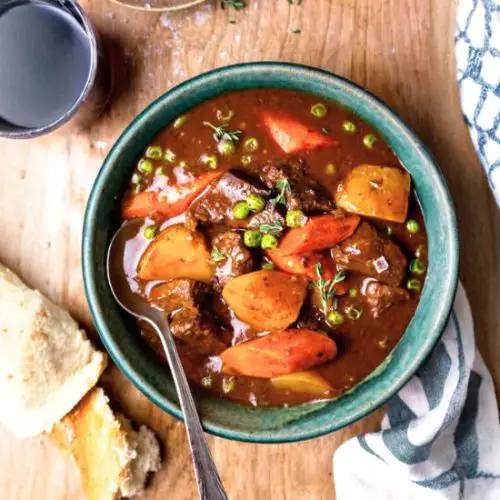
Protein-Packed Hearty Venison Stew
A rich, slow-cooked venison stew filled with tender chunks of meat, hearty vegetables, and a flavorful red wine sauce. Perfect for cozy dinners or meal prep, it’s both nutritious and satisfying.
Equipment
- 1 Dutch Oven (or Slow Cooker)
- 1 Chef’s knife
- 1 Wooden spoon
- Measuring Cups & Spoons
- Instant Pot (optional for pressure cooking)
Ingredients
- 3 tablespoons olive oil
- 2 pounds venison roast cut into 1–2" chunks
- 1 yellow onion diced
- 4 garlic cloves minced
- 2 tablespoons tomato paste
- ¼ cup all-purpose flour
- 1 cup red wine
- 1 tablespoon balsamic vinegar
- 1 tablespoon Worcestershire sauce
- 3 cups beef broth
- 2 cups water
- ½ teaspoon ground thyme
- 1 teaspoon salt
- ½ teaspoon black pepper
- 2 teaspoons granulated sugar
- 2 bay leaves
- 1 pound potatoes cut into 1–2" chunks
- 1 pound large carrots cut into 1–2" chunks
- 1 cup frozen peas
Instructions
- Prepare the Ingredients: Before you start cooking, gather and prep all your ingredients. Dice the yellow onion, mince the garlic, peel and cut the potatoes and carrots into 1–2 inch chunks, and measure out your flour, spices, and liquids. Cut the venison roast into 1–2 inch chunks, ensuring all pieces are roughly the same size to cook evenly.Having everything ready at the start will make the cooking process smooth and efficient.
- Sear the Venison: Heat 1 tablespoon of olive oil in a large Dutch oven or heavy-bottomed pot over medium-high heat. Once the oil shimmers, add half of the venison chunks in a single layer, making sure not to overcrowd the pan. Let the meat sear for about 5 minutes without moving it too much, allowing a golden-brown crust to form. Flip the pieces and sear the other side for an additional 3–5 minutes. Transfer the browned venison to a plate and repeat the process with the remaining pieces. This searing step locks in the juices and develops a rich, savory flavor base for the stew.
- Sauté the Aromatics: Add the remaining tablespoon of olive oil to the pot, then toss in the diced onion. Cook for 4–5 minutes, stirring occasionally, until the onion becomes soft and translucent. Add the minced garlic and cook for another minute until fragrant, then stir in the tomato paste. Cooking the tomato paste briefly enhances its natural sweetness and deepens the overall flavor of the stew.
- Combine Venison and Flour: Return the seared venison to the pot along with any accumulated juices. Sprinkle the all-purpose flour over the meat and stir well to coat evenly. The flour will help thicken the stew as it simmers, creating a luscious, velvety sauce. Make sure every piece of meat is lightly dusted and mixed thoroughly with the aromatics.
- Deglaze the Pot: Slowly pour in the red wine, balsamic vinegar, and Worcestershire sauce while scraping the bottom of the pot with a wooden spoon. This process, called deglazing, lifts the flavorful browned bits from the bottom, incorporating them into the liquid and intensifying the stew’s depth of flavor. Allow the mixture to simmer for 1–2 minutes to reduce slightly and blend the flavors.
- Add Broth and Seasonings: Pour in the beef broth and water, then add thyme, salt, pepper, granulated sugar, and bay leaves.Stir to combine. Bring the liquid to a gentle simmer over medium heat. This seasoning blend balances the savory, sweet, and tangy notes of the stew while infusing the venison and vegetables with deep flavor as they cook.
- Slow-Cook the Venison: Cover the Dutch oven with a lid and either transfer to a preheated oven at 325°F or leave on the stove over low heat. Allow the stew to cook for 1 hour and 30 minutes. During this time, the venison will slowly become tender, releasing its natural juices into the sauce, creating a rich and hearty base.
- Add the Vegetables: After the initial cooking period, add the potato and carrot chunks to the pot.Stir gently to submerge them in the liquid. Cover again and continue cooking for another 1 hour and 30 minutes, until both the venison and vegetables are fork-tender. The slow cooking ensures that the flavors meld together, and the potatoes and carrots soak up the savory sauce beautifully.
- Finish with Peas and Remove Bay Leaves: In the final 5–10 minutes of cooking, stir in the frozen peas. This adds a pop of color, freshness, and extra fiber to the dish. Remove the bay leaves before serving to avoid any tough, inedible bits in the stew. Taste and adjust seasoning if needed, adding a little more salt or pepper to suit your preference.
- Serve and Enjoy: Scoop the hearty venison stew into bowls, ensuring each serving gets a generous mix of meat, potatoes, and carrots. Serve warm with crusty bread or a side salad for a complete, comforting meal. This stew also reheats beautifully, making it a great option for leftovers or meal prep throughout the week.
Notes
- Searing the venison is key: it locks in juices and creates a deep, rich flavor base.
- Use a semi-dry red wine for cooking; choose one you enjoy drinking.
- Cut venison into uniform 1–2” chunks for even cooking and optimal tenderness.
- Tougher cuts like shoulder, neck, or shank work best for slow-cooked stews.
- Adjust cooking time for larger pieces of meat to ensure fork-tender results.
- Frozen peas should be added at the very end to maintain texture and color.
- This stew can be made in a Dutch oven, on the stovetop, in a slow cooker, or an Instant Pot.